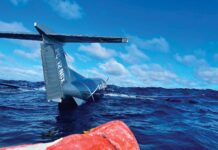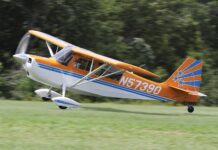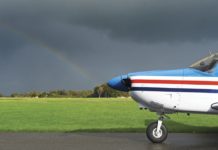Ever watch an airplane float down the runway before the wheels touch? Mooneys and other clean, long-winged planes are prone to this, especially when their pilots carry a little too much airspeed down the final. How about someone doing a soft-field takeoff, who staggers into the air, nose-high, while bystanders start taking bets on whether the plane will end up in the trees? Both are encountering ground effect, which is basically some free lifting energy produced when an airfoil-whether fixed, as with an airplane or glider, or rotating, as with a rotorcraft-is 288 within a certain distance from a surface, but both also are mishandling it. Many pilots fight ground effect because it interferes with their carefully planned approach and landing by preventing a smooth transition from flying to rolling. Others, especially when taking off on a hot day, are non-plussed to find they can get up off the runway just fine, but cant climb until they either lower their angle of attack or the airplane accelerates to a higher speed. Both types of pilots are fighting a natural phenomenon-and theyll never win. Ground effect, sometimes called the wing-in-ground effect, is a fact of life whenever were operating an airplane, glider or rotorcraft close to the ground. Instead of fighting it, our two hapless pilot types should be thinking about how to use ground effect to their advantage. Lets discuss how it can be done. What is ground effect? Whenever an airfoil comes within less than its span above the ground, or a body of waters surface, the ground effect phenomenon takes place. One result is a reduction in the induced drag created when the wing is making lift. Another is the pilots ability to reduce his/her aircrafts angle of attack, while still managing to generate sufficient lift to remain airborne. But how does that happen? How does the wing “know” its a short distance above a surface? Well, the wing doesnt “know” anything-its just a wing, after all. But to understand how ground effect occurs, we need to go back, briefly, to Aerodynamics 101. Thats where we learned about the static pressure differential between the upper and lower surfaces of a wing. The upper surface, of course, experiences reduced pressure while the lower ones is relatively higher. Depending on the theory of lift to which you subscribe, the reduced upper-wing pressure “sucks” the wing into the sky or the higher pressure under the wing supports the wing. Regardless, and due in part to combining the wings curved shape with its angle of attack, air is accelerated downward when its in motion. At altitude, of course, theres no reaction between this downward-forced air and the wing because theres nothing against which it can react. Close to a hard surface like pavement, grass or a body of water, the downward-forced air bounces back against the wings underside, effectively increasing the pressure against that surface. The principal result, and the one with which were most interested, is the wing therefore generates more lift for the given combination of airspeed and angle of attack. And more lift is good, right? Well, most of the time, it is. Except when were trying to land, for instance. But well get to that. By now, some neurons should be clicking back to Aerodynamics 101, where the instructor may have mentioned any time lift is produced, so is drag. In fact, theres a direct relationship between increased lift and increased drag. Its called induced drag, and it works against us by exerting a force (more or less) “equal and opposite” to the lift being produced. After all, theres no free lunch, right? Well, maybe there is. The other thing going on when flying in ground effect is wingtip vortices-created by spanwise airflow across the top of the wing-are minimized. In fact, flying a wing in ground effect also interferes with wingtip vortices formation, thereby further decreasing the drag produced by creating lift. Combining the two factors encountered when flying in ground effect-minimized wingtip vortices and relatively higher pressure acting against the wings underside-means we sort of do get a free lunch close to the ground. Taking off So, how can use it to our advantage? One of the more obvious ways to use ground effect to our advantage comes when were taking off. The most useful way to employ ground effect is to fly in it just after liftoff while the airplane accelerates. This is particularly advantageous when taking off from a soft field, one at which we want to get the airplanes weight off the wheels or floats and onto the wings as soon as possible. Think about it: The major challenge of a soft-field takeoff is posed because the surface were rolling on exerts greater drag than, say, clean and dry pavement. Tall grass, muddy terrain and loose material like sand or gravel all exact some performance penalty by creating greater friction (when compared to dry pavement), thereby preventing the airplane from quickly accelerating to its liftoff speed. But how to use ground effect to overcome a soft fields greater drag? Its really fairly simple, and the sidebar at left outlines some recommended steps. The key, however, is getting airborne at minimum airspeed, and then pitching the nose down to a level-flight attitude while maintaining an altitude keeping the airplane in ground effect and accelerating to an appropriate climb speed (VX, best angle of climb, or VY, best rate, whichever is most appropriate). This is pretty much the description of the classic soft-field takeoff and presumes either no obstructions to interfere with zooming along just above the takeoff surface for a few seconds after liftoff, or an operational need to minimize the ground roll and accelerate to VX as quickly as possible to climb above the trees ahead. Its also the same technique we might want to use when departing a snowy, slushy runway or at any other time we have an operational need to get airborne as quickly as possible but dont need to climb immediately. In the case of the snowy/slushy runway, in fact, we might want to accelerate to a speed even higher than VY before climbing or retracting the landing gear to allow the slipstream to blow off the contamination as much as possible. If your instructor never went over and practiced this maneuver with you, find one who knows what theyre doing and get some dual on it before trying it for real. Landing It might come as a surprise to think ground effect also can be used to our advantage when landing. The surprise factor comes when we consider ground effect increases lift at the one time during the flight when excess lift is the last thing we want. The trick is to anticipate ground effects, umm, effect on our landing, but it takes a bit more planning than when taking off. Before getting to how we can use ground effect on landing, lets spend a moment reviewing why we might want to use it. First of all, lets agree that not every runway is the same, and the technique we might employ when landing on the 14,511 feet of clean, clear, dry pavement presented by Runway 13R/31L at the John F. Kennedy International Airport, for example, isnt the same well want to use when making an approach to the much shorter strip out behind Uncle Billy Bobs catfish pond. In the former, we might want to fly a mile or so down the runway, decelerating all the while to avoid getting run over by the Airbus steaming up behind us before plopping onto the ground and aiming for the nearest high-speed taxiway. At Billy Bobs, however, we want to be on-speed and on our touchdown target, lest we embarrass ourselves in front of the whole family and roll off into the compost heap he so thoughtfully put at the runways far end. Were not going to delve into the recommended planning and techniques for an accuracy landing in this article-for a refresher on that topic, be sure to check the article, “Accuracy Landings,” in last months issue. Instead, were going to explore when in the landing process we might want both to use a little extra lift and anticipate effect. With most airplanes, we descend to the runway, managing pitch and power to arrive over the intended landing area at the desired height and speed. We flare, reduce power appropriately, and the wheels settle onto the surface. If, however, we forget about ground effect and/or carry a bit too much speed, we can easily find ourselves floating off into the compost heap at the far end. Again, the key here is anticipating and planning for ground effect. How do we do that? By establishing a level or near-level flight attitude as we enter ground effect, and using the extra lift generated to keep the nose coming up to the desired attitude and the airplane above the runway until were over our intended touchdown spot while continuing to decelerate. The beauty of using ground effect in the landing is we can always use the extra lift being generated to slow down, get the nose up and ensure touching down on the mains when flying a tricycle-gear airplane, or a three-pointer when alighting in a taildragger. Better yet, we can already be slow and pitching up to the flare attitude as we enter ground effect. Ive used some variation of this landing-in-ground-effect technique for some time. It works, its repeatable and helps ensure touching down at the lowest possible speed. If you have been having troubles with your landings-whether the difficulty is getting the nose up into the flare, managing airspeed or properly anticipating/reacting to entering ground effect-you might want to consider making it work for you, not against you, on landing. Caveats As with any new technique or procedure, you may want to consider how well-suited your airplane and the landing surface are to using it. For example, and as the sidebar on page 21 addresses, ground effect begins within a wingspan above the surface and its effects are greatest just before touchdown. The principal thing to keep in mind, especially if you fly a range of high- and low-wing airplanes, is ground effect will be more pronounced in a low-wing aircraft, all things being equal, than one with a high wing. Get some dual, practice getting into and out of ground effect, and compare the before/after takeoff and landing performance you achieve when anticipating and using ground effect. You might be surprised at what youve been missing.



